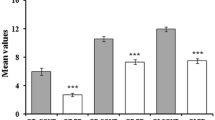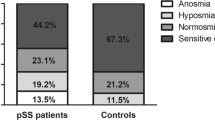Abstract
The aim of our study was to analyze olfactory function in patients with idiopathic inflammatory myopathies (IIM). We performed a case–control study on 60 IIM patients (48 females and 12 males) and 60 healthy controls (HC) recruited by the best friend method, matched for age, sex and lifestyle. Olfactory function was analyzed by “Sniffin’ sticks test” and expressed through a score (TDI), indicating normosmia (TDI > 30), hyposmia (TDI 15–30) and anosmia (TDI < 15). Mood was investigated by Beck depression inventory (BDI) test. Statistic was performed using SPSS package. Mean ± SD TDI was significantly reduced in patients versus HC (26.8 ± 5.2 vs. 31.4 ± 3.5, p < 0.001). Anosmia was detected in two patients (3.3 %) and no HC, hyposmia in 41 patients and 14 HC (68.3 vs. 23.3 %, p < 0.0001) and normosmia in 17 patients and 48 HC (28.3 vs. 76.6 %, p < 0.0001). In the multivariate analysis carried out in the pool population of patients and HC, low TDI score was associated with age ≥50 years (p < 0.0001), disease status (p < 0.0001) and high BDI (p = 0.007). When adjusting for BDI, disease status was still associated with low TDI (p = 0.037). In IIM, TDI was lower in subjects aged ≥50 years (p = 0.008) and in patients who were taking corticosteroids (p < 0.0001). In the multivariate analysis carried out in IIM patients, low TDI was associated with age ≥50 years (p = 0.001) and prednisone intake (p < 0.0001). The olfactory function is impaired in IIM patients. An underlying immune-mediated mechanism is conceivable, yet a possible interference due to age, steroid intake and depression should be considered.
Similar content being viewed by others
References
Perricone C, Shoenfeld N, Agmon-Levin N, de Carolis C, Perricone R, Shoenfeld Y. Smell and autoimmunity: a comprehensive review. Clin Rev Allergy Immunol. 2013;45:87–96.
Benkler M, Agmon-Levin N, Shoenfeld Y. Parkinson’s disease, autoimmunity, and olfaction. Int J Neurosci. 2009;119:2133–43.
Makowska I, Kloszewska I, Grabowska A, Szatkowska I, Rymarczyk K. Olfactory deficits in normal aging and Alzheimer’s disease in the polish elderly population. Arch Clin Neuropsychol. 2011;26:270–9.
Erb K, Bohner G, Harms L, Goektas O, Fleiner F, Dommes E, Schmidt FA, Dahlslett B, Lüdemann L. Olfactory function in patients with multiple sclerosis: a diffusion tensor imaging study. J Neurol Sci. 2012;316:56–60.
Shoenfeld N, Agmon-Levin N, Flitman-Katzevman I, Paran D, Katz BS, Kivity S, Langevitz P, Zandman-Goddard G, Shoenfeld Y. The sense of smell in systemic lupus erythematosus. Arthritis Rheum. 2009;60:1484–7.
Kamel UF, Maddison P, Whitaker R. Impact of primary Sjogren’s syndrome on smell and taste: effect on quality of life. Rheumatology (Oxford). 2009;48:1512–4.
Katzav A, Solodeev I, Brodsky O, Chapman J, Pick CG, Blank M, et al. Induction of autoimmune depression in mice by anti-ribosomal P antibodies via the limbic system. Arthritis Rheum. 2007;56:938–48.
Shoenfeld Y. To smell autoimmunity: anti-P-ribosomal autoantibodies, depression, and the olfactory system. J Autoimmun. 2007;28:165–9.
Katzav A, Ben-Ziv T, Chapman J, Blank M, Reichlin M, Shoenfeld Y. Anti-P ribosomal antibodies induce defect in smell capability in a model of CNS –SLE (depression). J Autoimmun. 2008;31:393–8.
Katzav A, Ben-Ziv T, Blank M, Pick CG, Shoenfeld Y, Chapman J. Antibody-specific behavioral effects: intracerebroventricular injection of antiphospholipid antibodies induces hyperactive behaviour while anti-ribosomal-P antibodies induces depression and smell deficits in mice. J Neuroimmunol. 2014;272:10–5.
Matus S, Burgos PV, Bravo-Zehnder M, Kraft R, Porras OH, Farías P, et al. Antiribosomal-P autoantibodies from psychiatric lupus target a novel neuronal surface protein causing calcium influx and apoptosis. J Exp Med. 2007;204:3221–34.
Fasunla JA, Hundt W, Lutz J, Förger F, Thürmel K, Steinbach S. Evaluation of smell and taste in patients with Wegener’s granulomatosis. Eur Arch Otorhinolaryngol. 2012;269:179–86.
Proft F, Steinbach S, Dechant C, Witt M, Reindl C, Schulz S, Vielhauer V, Hilge R, Laubender R, Manger K, Nüsslein H, Wendler J, Schuch F, Schulze-Koops H, Grunke M. Gustatory and olfactory function in patients with granulomatosis with polyangiitis (Wegener’s). Scand J Rheumatol. 2014;10:1–7.
Ghirardello A, Zampieri S, Tarricone E, Iaccarino L, Gorza L, Doria A. Cutting edge issues in polymyositis. Clin Rev Allergy Immunol. 2011;41:179–89.
Ghirardello A, Bassi N, Palma L, Borella E, Domeneghetti M, Punzi L, Doria A. Autoantibodies in polymyositis and dermatomyositis. Curr Rheumatol Rep. 2013;15:335.
Tarricone E, Ghirardello A, Rampudda M, Bassi N, Punzi L, Doria A. Anti-SAE antibodies in autoimmune myositis: identification by unlabelled protein immunoprecipitation in an Italian patient cohort. J Immunol Methods. 2012;384:128–34.
Zampieri S, Biral D, Adami N, Ghirardello A, Rampudda ME, Tonello M, Doria A. Expression of myositis specific autoantigens during post-natal myogenesis. Neurol Res. 2008;30:145–8.
Ghirardello A, Zampieri S, Iaccarino L, Tarricone E, Bendo R, Gambari PF, Doria A. Anti-Mi-2 antibodies. Autoimmunity. 2005;38:79–83.
Franceschini F, Cavazzana I, Generali D, Quinzanini M, Viardi L, Ghirardello A, Doria A, Cattaneo R. Anti-Ku antibodies in connective tissue diseases: clinical and serological evaluation of 14 patients. J Rheumatol. 2002;29:1393–7.
Iaccarino L, Gatto M, Bettio S, Caso F, Rampudda M, Zen M, Ghirardello A, Punzi L, Doria A. Overlap connective tissue disease syndromes. Autoimmun Rev. 2013;12:363–73.
Lega JC, Fabien N, Reynaud Q, Durieu I, Durupt S, Dutertre M, Cordier JF, Cottin V. The clinical phenotype associated with myositis specific and associated autoantibodies: a meta-analysis revisiting the so called anti-synthetase syndrome. Autoimmun Rev. 2014;13:883–91.
Mahler M, Miller FW, Fritzler MJ. Idiopathic inflammatory myositis and anti-synthetase syndrome: a comprehensive review. Autoimmun Rev. 2014;13:367–71.
Zampieri S, Ghirardello A, Iaccarino L, Tarricone E, Gambari PF, Doria A. Anti-Jo-1 antibodies. Autoimmunity. 2005;38:73–8.
Bohan A, Peter JB. Polymyositis and dermatomyositis (first of two parts). N Engl J Med. 1975;292:344–7.
Bohan A, Peter JB. Polymyositis and dermatomyositis (second of two parts). N Engl J Med. 1975;292:403–7.
Hummel T, Sekinger B, Wolf SR, Pauli E, Kobal G. “Sniffin’ sticks”: olfactory performance assessed by the combined testing of odor identification, odor discrimination and olfactory threshold. Chem Senses. 1997;22:39–52.
Rider LG, Werth VP, Huber AM, Alexanderson H, Rao AP, Ruperto N, et al. Measures of adult and juvenile dermatomypositis, polymyositis and inclusion body myositis. Arthritis Care Res. 2011;63:S118–57.
Ghirardello A, Rampudda M, Ekholm L, Bassi N, Tarricone E, Zampieri S, Zen M, Vattemi GA, Lundberg IE, Doria A. Diagnostic performance and validation of autoantibody testing in myositis by a commercial line blot assay. Rheumatology (Oxford). 2010;49:2370–4.
Beck AT, et al. Comparison of Beck Depression Inventories -IA and -II in psychiatric outpatients. J Pers Assess. 1996;67:588–97.
van Exel E, Jacobs J, Korswagen L-A, Voskuyl AE, Stek M, Dekker J, Bultink IEM. Depression in systemic lupus erythematosus, dependent on or independent of severity of disease. Lupus. 2013;22:1462–9.
Mombaerts P. Love at first smell—the 2004 Nobel Prize in Physiology or Medicine. N Engl J Med. 2004;351:2579–80.
Doherty PC. On the nose: shared themes for the sensory and immune self. Nat Immunol. 2003;4:1043–5.
Kivity S, Ortega-Hernandez OD, Shoenfeld Y. Olfaction—a window to the mind. Isr Med Assoc J. 2009;11:238–43.
Ortega-Hernandez OD, Kivity S, Shoenfeld Y. Olfaction, psychiatric disorders and autoimmunity: is there a common genetic association? Autoimmunity. 2009;42:80–8.
Moscavitch SD, Szyper-Kravitz M, Shoenfeld Y. Autoimmune pathology accounts for common manifestations in a wide range of neuro-psychiatric disorders: the olfactory and immune system interrelationship. Clin Immunol. 2009;130:235–43.
Strous RD, Shoenfeld Y. To smell the immune system: olfaction, autoimmunity and brain involvement. Autoimmun Rev. 2006;6:54–60.
Nguyen AD, Shenton ME, Levitt JJ. Olfactory dysfunction in schizophrenia: a review of neuroanatomy and psychophysiological measurements. Harv Rev Psychiatry. 2010;18:279–92.
Silva AM, Santos E, Moreira I, Bettencourt A, Coutinho E, Gonçalves A, Pinto C, Montalban X, Cavaco S. Olfactory dysfunction in multiple sclerosis: association with secondary progression. Mult Scler. 2012;18:616–21.
Hummel T, Kobal G, Gudziol H, Macky-Sim A. Normative data for the “Sniffin’ Sticks” including test of odor identification, odor discrimination, and olfactory threshold: an upgrade based on a group of more than 3,000 subjects. Eur Arch Otorhinolaryngol. 2007;264:237–43.
Basta M, Dalakas MC. High-dose intravenous immunoglobulin exerts its beneficial effect in patients with dermatomyositis by blocking endomysial deposition of activated complement fragments. J Clin Invest. 1994;94:1729–35.
Ingram G, Hacobyan S, Robertson NP, Morgan BP. Complement in multiple sclerosis: its role in disease and potential as a biomarker. Clin Exp Immunol. 2009;155:128–39.
Perricone C, Agmon-Levin N, Shoenfeld N, de Carolis C, Guarino MD, Gigliucci G, Milana I, Novelli L, Valesini G, Perricone R, Shoenfeld Y. Evidence of impaired sense of smell in hereditary angioedema. Allergy. 2011;66:149–54.
Doty RL, Shah M, Bromley SM. Drug-induced taste disorders. Drug Saf. 2008;31:199–215.
Iaccarino L, Ghirardello A, Bettio S, Zen M, Gatto M, Punzi L, Doria A. The clinical features, diagnosis and classification of dermatomyositis. J Autoimmun. 2014;48–49:122–7.
Palagnini L, Mosca M, Tani C, Gemignani A, Mauri M, Bomabardieri S. Depression and systemic lupus erythematosus: a systematic review. Lupus. 2013;2:409–16.
Souza FH, Levy-Neto M, Shinjo SK. Prevalence of clinical and laboratory manifestations and comorbidities in polymyositis according to gender. Rev Bras Reumatol. 2011;51:428–83.
Croy I, Symmank A, Schellong J, Hummel C, Gerber J, Joraschky P, Hummel T. Olfaction as a marker for depression in humans. J Affect Disord. 2014;160:80–6.
Naudin M, El-Hage W, Gomes M, Gaillard P, Belzung C, Atanasova B. State and trait olfactory markers of major depression. PLoS One. 2012;7:e46938.
Pinto JM, Wroblewski KE, Kern DW, Schumm LP, McClintock MK. Olfactory dysfunction predicts 5-year mortality in older adults. PLoS One. 2014;9:e107541.
Conflict of interest
The authors declare no conflicts of interest.
Ethical standard
This study was approved by the local ethics committee.
Informed consent
All patients gave informed written consent.
Author information
Authors and Affiliations
Corresponding author
Rights and permissions
About this article
Cite this article
Iaccarino, L., Shoenfeld, N., Rampudda, M. et al. The olfactory function is impaired in patients with idiopathic inflammatory myopathies. Immunol Res 60, 247–252 (2014). https://doi.org/10.1007/s12026-014-8581-5
Published:
Issue Date:
DOI: https://doi.org/10.1007/s12026-014-8581-5




